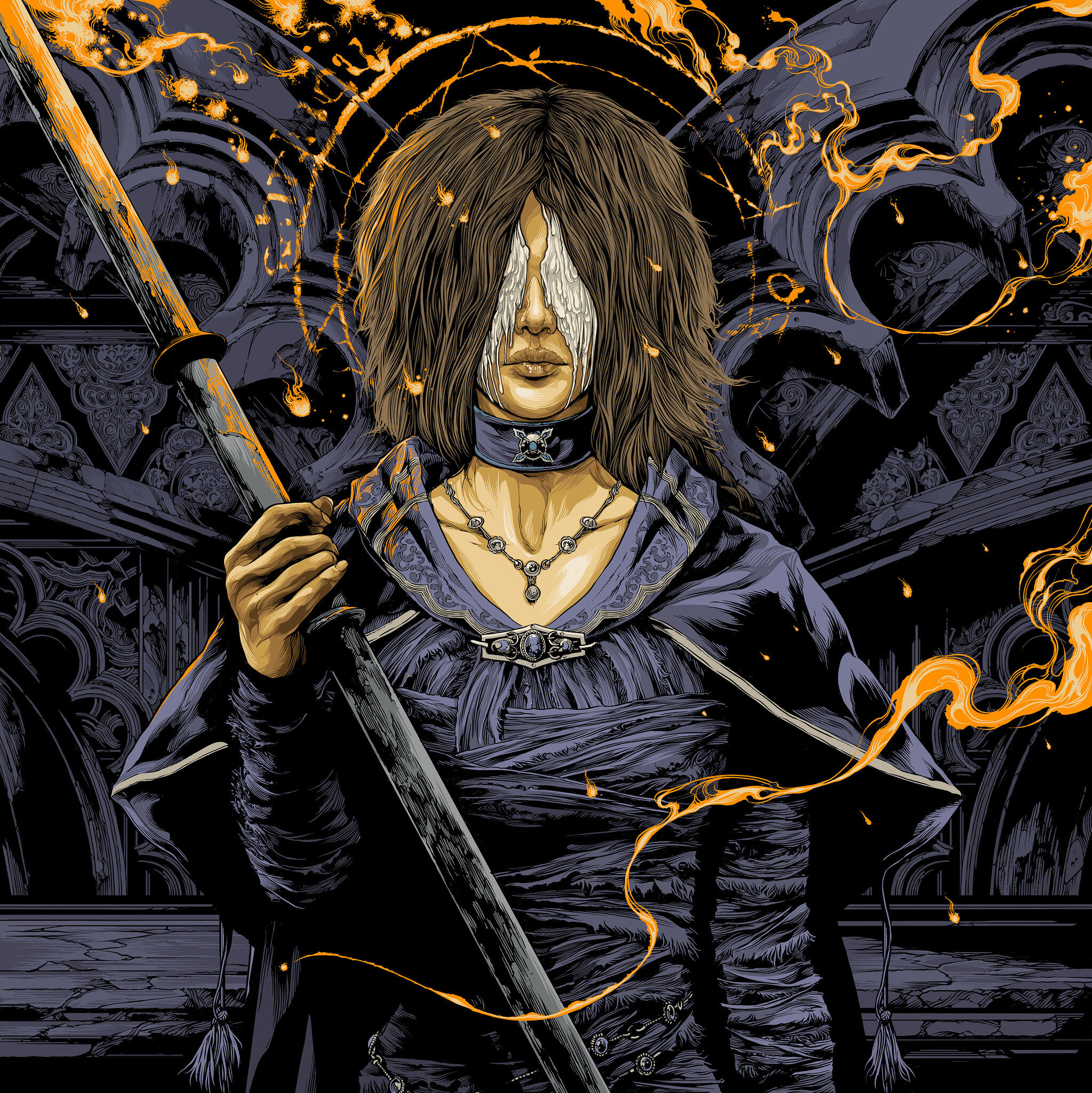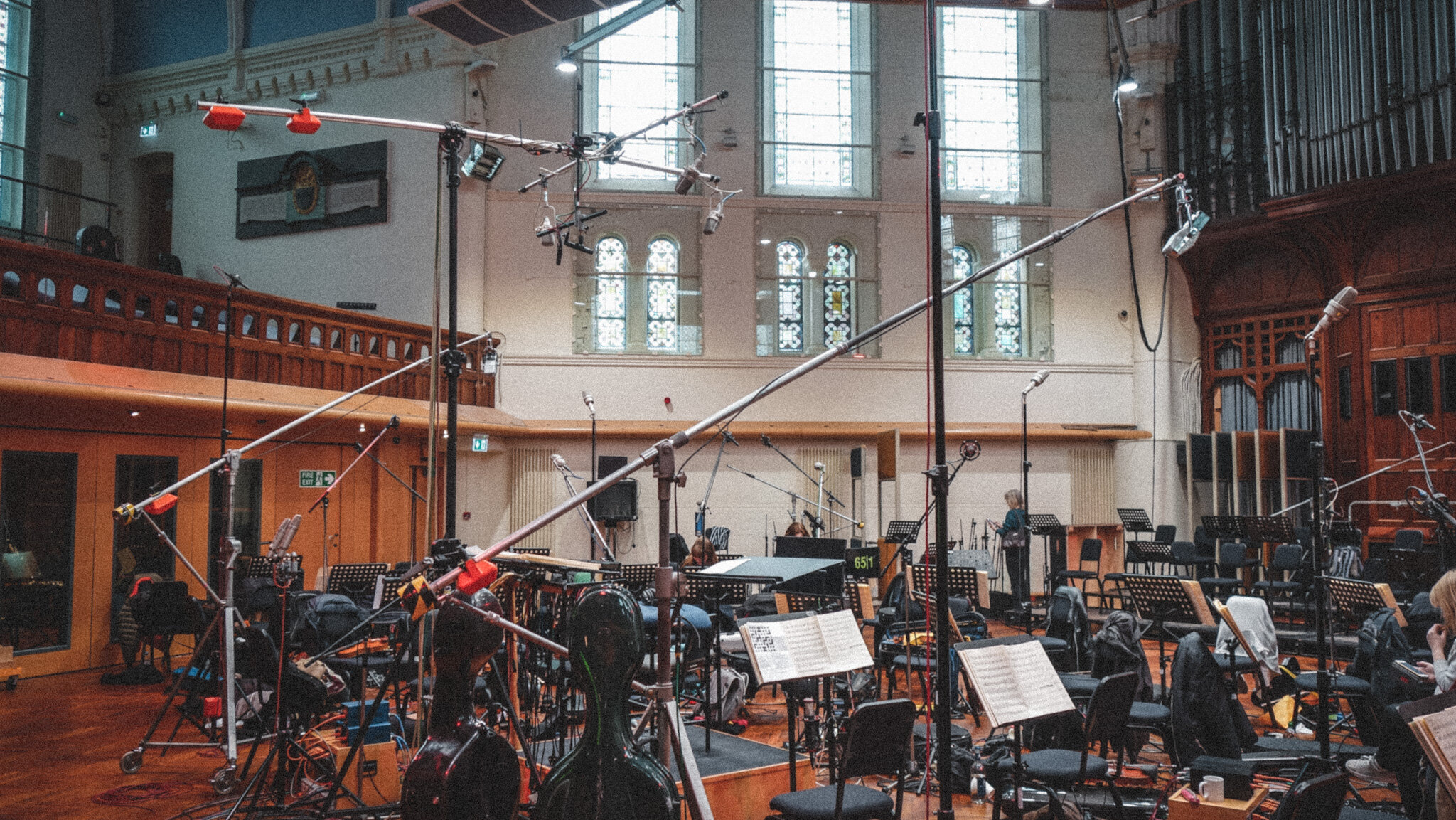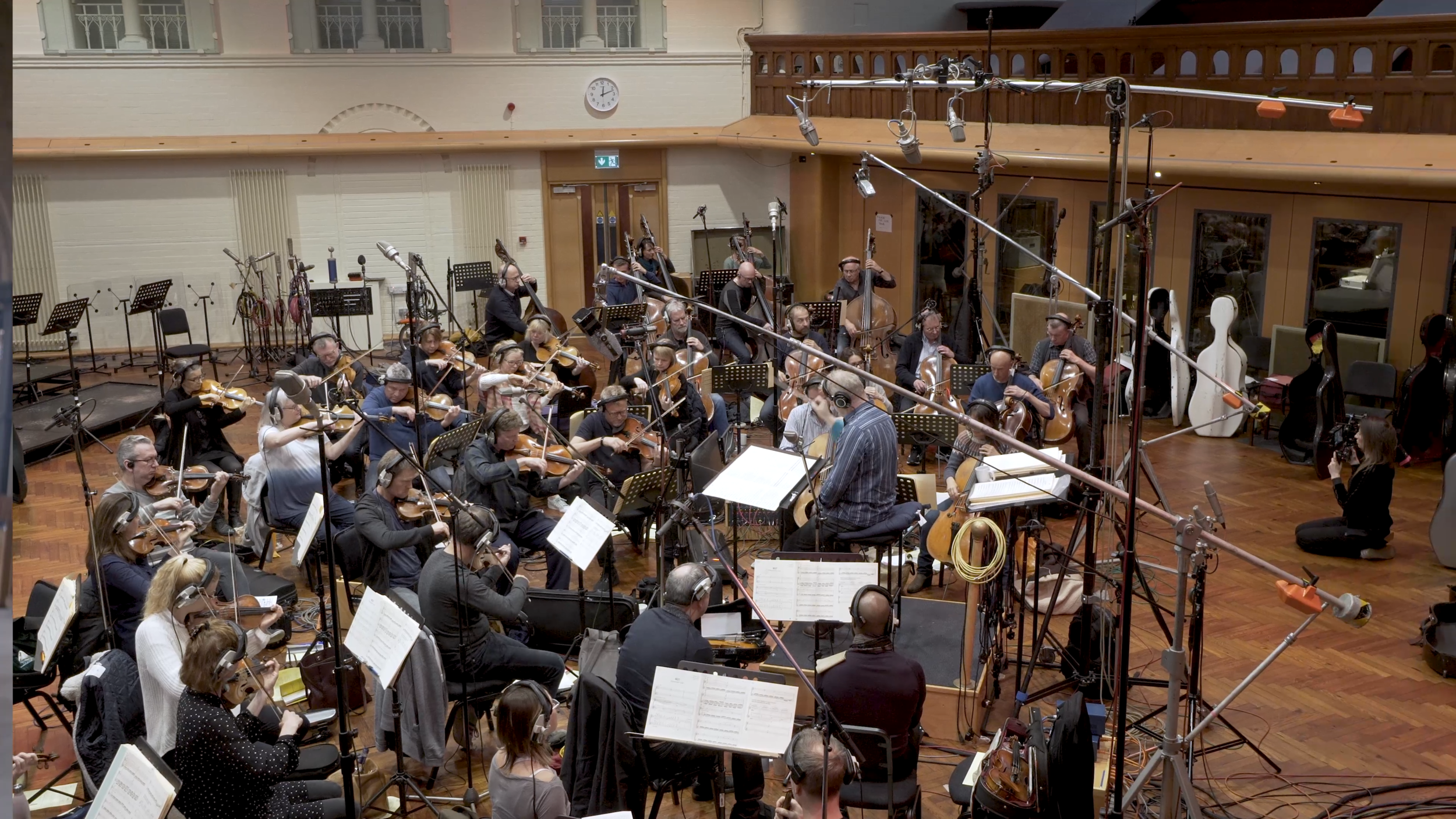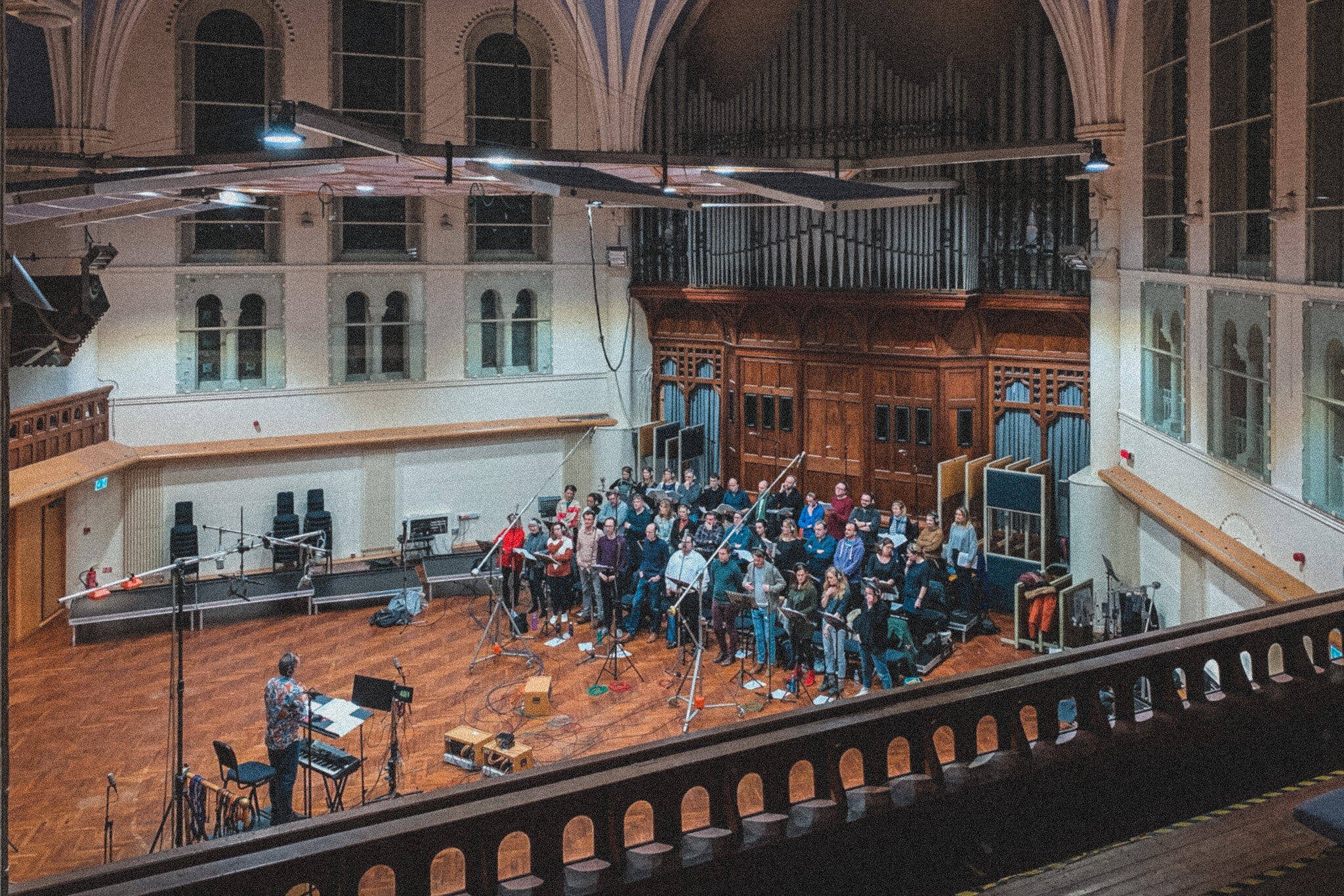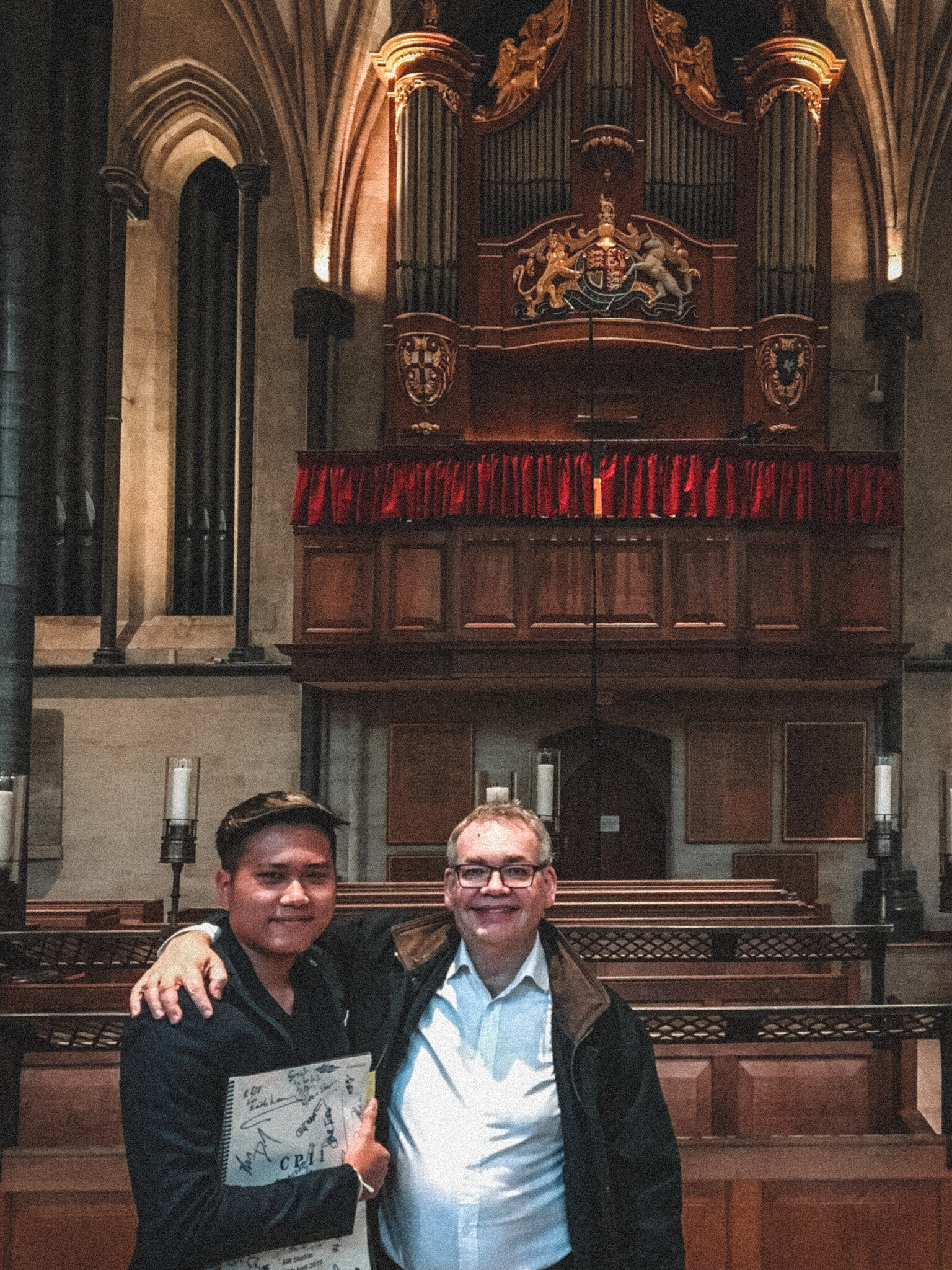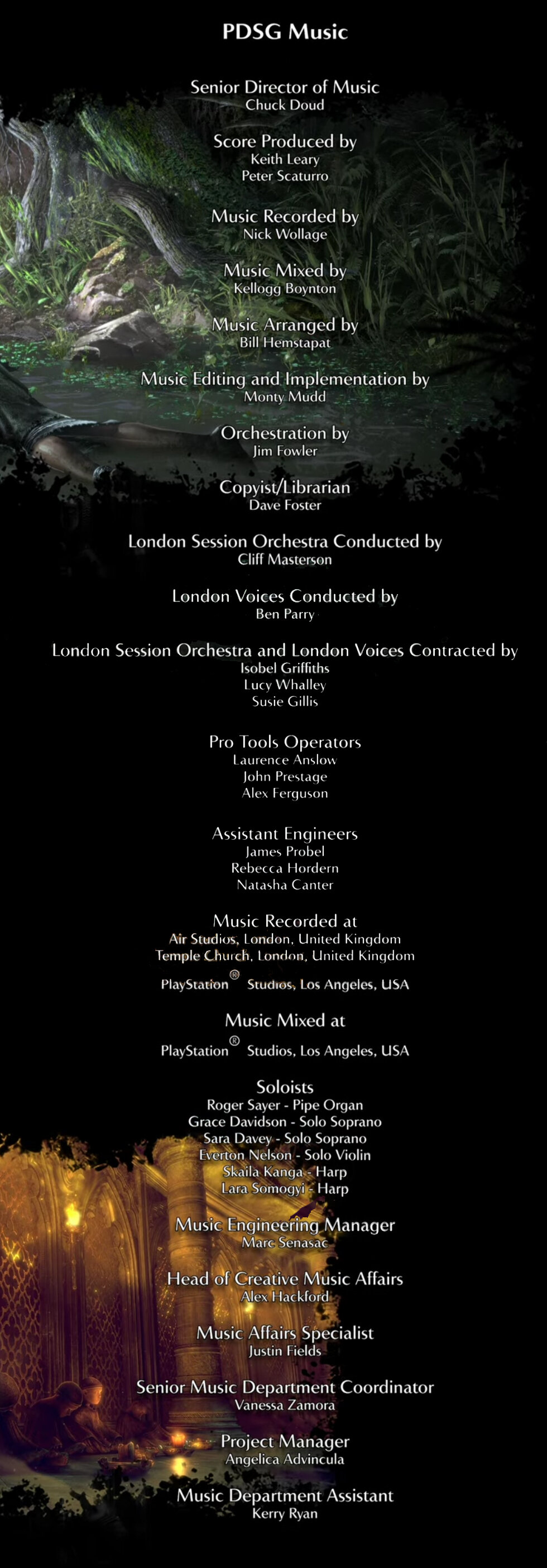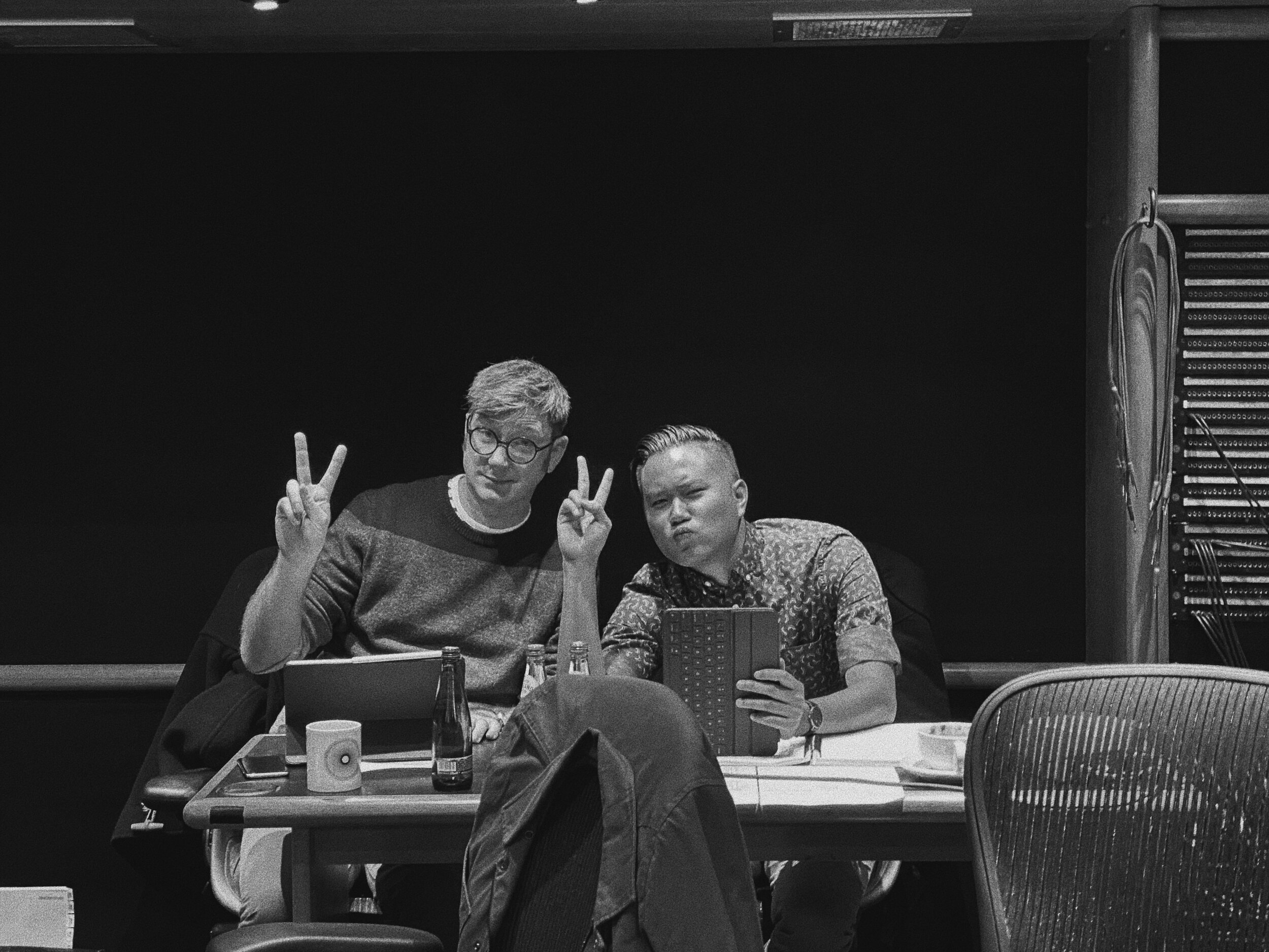Bill Hemstapat
Composer | Music Designer
THE Arranger’s Diary - Demon’s Souls (PS5)
“The new soundtrack is so tremendously good. The orchestral score is suitably grand and complements the big boss fights beautifully. It does wonders for the game’s tone and helps to make everything feel far more significant in a way that the original’s more manufactured-sounding score probably wanted to but couldn’t quite pull off with its limited budget. This is the soundtrack that Demon’s Souls deserves.”
Demon’s Souls is finally out on PS5! I’d like to first congratulate Japan Studios and Bluepoint on this incredible release. I’d also like to congratulate my Sony PlayStation music/sound department colleagues on an incredible sounding game. I’m incredibly grateful for this once in a lifetime opportunity to not only re-imagine Shunsuke Kida’s iconic score for Demon’s Souls, but to also be a part of a major moment of gaming history that is the launch of the PS5.
This was a big responsibility. Like, really big, and, in some moments, it felt like I wasn’t ready for the job. There was a lot of fear and self-doubt running through me over the 2 years and 5 months that I worked on this game. Many times this was because I had this voice in my head of the fans repeatedly saying that they hate my work and now recently those voices are starting to turn into real life comments from the internet.
The only way that I’ve been able to cope with all of this has been to give everything I have. Knowing that I’ve done everything I possibly can makes me feel better. This blog is an honest diary of me “giving it my all” to this opportunity of a lifetime.
If you’re ready - let’s dive right in!
Chapter 1 - Why Remake?
“Why change something that’s already so iconic?”
There’s no denying that there were some flaws for the PS3 version of Demon’s Souls. But these “flaws” have become a part of the experience that fans of the game have come to love. The music is a part of that too. Compared to other Souls games, the original Demon’s Souls has the smallest ensemble and relies very heavily on MIDI production with very little live recording. But there are a large number of fans that fell in love with this score, and its sound, through the memories they have from playing the game.
The remake for the PS5 presents a new challenge. With the improved graphic fidelity and all the details that Bluepoint Studios has added to the game, it felt like the original music wasn’t supporting the story anymore. Castle walls that were once flat brown bricks now have vines, cracks, and engravings - a sense of history perhaps. The world feels much more “lived-in” and the details provide a sense of what may have happened in this world or how it came to be the way that it is. Ultimately, the depth of the storytelling is greatly increased.
This is something we needed to address. But how do we do that without losing everything fans have come to know and love about the original soundtrack?
I am not Shunsuke Kida
“I’m not Jordan Cronenweth. I could not light like Jordan, I didn’t even want to go there. I mean, I kinda light in a naturalistic way, a simpler way. And he’s got his style with so much more classic and cuts in a wonderful way. I couldn’t do that.”
There’s something obvious here that is worth pointing out: I can never be Shunsuke Kida. And by that, I really mean no matter how much I try I will never sound like him. We were brought up with very different musical backgrounds/experiences. There are also external factors and circumstances related to the time that these two games came out (2009 and 2020); the budget, the current gaming culture and technology, to name a few. We would be setting ourselves up for failure by trying to replicate all of those factors.
Kida-san’s original soundtrack will always live in people’s hearts as a classic; a masterpiece that will be respected and remembered as the music that started it all. However, this is a chance to create something different. Something that is an extension of his work and not a replacement. Something that, in its own right, can have a unique place in this wonderfully wacky Souls-Borne-Sekiro series.
Chapter 2 - Philosophies
My philosophy as a music arranger is to create a “presentation” of Kida-san’s music. I am aiming to re-present it to the world in the best way we possibly can utilizing the capabilities of the PS5.
“Keeping the SOUL of the original”
For every piece that I’m re-arranging, my first mission is to identify what the “soul” of the piece is. And by that, I mean the very core musical idea that makes the piece what it is. In most cases, it’s a complete melody, and in some cases its a short “melodic motif”. For example, if we ask what players remember about the Tower Knight theme, their first instinct will gravitate toward the infamous “HA hahaha HA” rather than the fully formed melody from the B section.
With this “soul” identified (no pun intended!), no matter how much the arrangement has changed around it, it will always be identifiable as the Tower Knight theme as soon as you hear the 5 note motif.
A snippet of written music from the Tower Knight theme. “Turrim Eques” is latin for Tower Knight.
“This is not just a game anymore, it’s a FRANCHISE.”
While the original Demon’s Souls was an AAA production, it became more of a “cult hit” compared to other major releases that same year, like Uncharted 2: Among Thieves, a worldwide blockbuster. This might be due to the accessibility differences between the two games. Demon’s Souls has an incredibly high barrier of entry; you need to practice, study the boss moves, and fail again and again to get good! Whereas with the Uncharted series, it’s a relative breeze of a journey focusing on familiar storytelling tropes. Let’s also not forget that Demon’s Souls was the first of it’s kind. There had never been anything quite like it in the market at the time.
But things are different now. There have been 5 From Software games following Demon’s Souls, and each of them has increased the franchise’s popularity. Think about it, a game so strong it created its own genre; how unbelievable is that? If you have no idea what I’m talking about, I highly encourage you to watch the video by Game Maker’s Toolkit that’s linked below about the “Souls-like” genre.
One of the main factors that has made the Souls games more popular over the years is the incremental accessibility improvements while keeping the core experience the same. For example, the dodge-rolling mechanic in Demon’s Souls was a “fixed” direction making it hard to perform without hours of practice. By the time Dark Souls 3 came around, the dodge rolling mechanic improved IMMENSELY, allowing players to have more of a chance to fight back. Also, an online community developed that posted tips, tricks, guides, and strategies that have helped new players.
With the franchise development in mind, Kida-san’s music is undeniably much more experimental than the rest of the series. While many fans have come to love the soundtrack, it was not everybody’s cup of tea compared to hits like “The Cleric Beast” from Bloodborne, or “Soul of Cinder” from Dark Souls 3 or Gwyn’s theme from Dark Souls 1. This makes it the least popular soundtrack of the entire franchise, as was the game itself.
With that, I had a mission in my mind to make the Demon’s Souls music more accessible and feel more “familiar” to new-comers as well as veteran Souls fans. I took inspiration from a whole decade of games that have come after it when making arrangement decisions while, most importantly, infusing the “soul” of the original music.
What I’ve learned from the past games
To fully modernize the new music, it was vital for me to understand how the music for the souls series came to be the way it is. And since I’ve already studied Kida-san’s score for the original Demon’s Souls, I now needed to analyze every score of the Souls franchise.
The Somberness of Dark Souls
Our first victim is the very first Dark Souls. It’s the very thing that started the franchise’s main stream popularity. And I couldn’t think of a better place to start than digging into Motoi Sakuraba’s theme for Gwyn, Lord of Cinder or what is colloquially known by Dark Souls fan as “Plin Plin Plon”.
After investigating many pieces, it became apparent to me that while the music for Dark Souls is big, dark, and epic, one of the most important elements that fans have connected to is this “somber undertone” that lives within every piece of music. Gwyn’s theme is a big shinning example of that. For a final boss fight that you think would be big and bombastic, Sakuraba-san went with a somber and reflective piano solo and the rest is history.
This very same approach was also used on Tsukasa Saitoh’s The First Hunter from our next victim in line, Bloodborne.
The Epic Sinister Horror of Bloodborne
One of the coolest thing about working on Demon’s Souls under Sony PlayStation is that I’m already working with half of the team that’s behind the incredible music of Bloodborne. Peter Scaturro, who many of you may know from my Ghost of Tsushima blog as my boss, was a score producer on Bloodborne. Jim Fowler was also one of the orchestrators of that game.
The thing about Bloodborne ‘s score that really stood out to me from the rest of the franchise, aside from its epicness, is the gestural writing that came from the use of aleatoric effects.
For those who are a little bit more unfamiliar with this term, Aleatoric Music is sometimes referred to as “chance music” (Alea being latin for “dice”). This means that some element of the composition are left to chance, and/or some primary element of a composed work's realization is left to the determination of its performer(s). A great example for this is The Witch of Hemwick, which utilizes many aleatoric string rise/fall/cluster textures as a back drop for it’s haunting melody.
This element of unpredictability creates anxiety and tension, which is incredibly appropriate for a game like Bloorborne. I highly encourage those who are a fans of the game to dive into this GDC presentation video led by Pete and Jim as well as Penka Kouneva about its music production and approach.
The Haunting Melodies of Dark Souls 3
There are many great melodies in the Souls franchise, but for some reason the ones from Dark Souls 3 have always been the catchiest and most memorable out of them all. We talk about how Dark Souls has the somberness undertone and that is still present here. But with Dark Souls 3, there seems to be somewhat of an emphasis on simplistic and memorable melodic writing. The use of solo female soprano, which was also present on Bloodborne, further gives that haunting connection to us as humans.
The choir and string writing here is also top notch. It has definitely shown that they have fully developed the sound of the franchise and if there’s such a thing as musical transformation, the music for Dark Souls has reached its “final form” here.
I should highlight that I’ve personally always found Yuka Kitamura’s work to be incredibly inspiring. And a lot of her work on Dark Souls 3 has definitely informed some of my arrangements.
Chapter 3 - THE NEXT STEPS
Inspirations from Ancient and Sacred Music
I mentioned earlier that the world of this PS5 remake feels more “lived-in” and has a sense of great history of what came before it. I was faced with the challenge of further communicating this to the players while, again, still remaining true to the original score. Well where do I start?
I started looking at music in our history that’s NOT a soundtrack to anything, that could somewhat represent the period of time Demon’s Souls might be set in. The architecture of Boletaria is somewhat a resemblance of European architecture in the 12th century or perhaps even older than that. The closest documented materials in our world that would closely represent this would be music during Renaissance and Medieval times.
Most of the music during that time was used in religious context, particularly in church. They have a long history of evolution from the gregorian chants during 9th-10th century moving further to choral works in the 16th century like Bach or this Missa Papae Marcelli piece by Palestrina (see below), and even more modern works like Hymn of the Cherubim by Tchaikovsky.
Something told me that Demon’s Souls could benefit from this, especially something related to the Nexus. This kind of choral writing, which is soft, sacred and meditative, will only enhance the feeling of a safe sacred place for people to voice their prayers. While it’s a fictional one, there are some parallels here that could help ground the score into a more immersive, and perhaps believable reality. If you listen to a new arrangement of Maiden in Black as well as a few new cues accompanying the Nexus cutscenes, you will clearly hear some of these influences being sprinkled all over - adding depth into Kida-san’s old theme.
the Latin lyrics
If you’ve played the original, there’s no doubt that you would remember the infamous “Ha-ha-ha-ha-Ha” from the original Tower Knight boss theme. As you’ve noticed from the picture earlier, it has been replaced with Latin lyrics in this remake. With these lyrics, there is more opportunity to tell a story for each boss through music - making each boss feel even more unique and further adding depth to the experience. An iconic vocal centric piece from the original score like Return to Slumber is getting a lot out of this treatment.
Here are some lyrics and translations for this new remake version:
Latin
Animarum Dominus, Redire ad Somnum
Una Spes Ultima Infinita Imperium
Interfectorum Daemonium,
Contempto Alta Nebula
Redire ad Somnum
Imperium Animarum
Requiem, Redire Somnum
Luxin Tenebris Lucet
Devoratum Animarum
Magna Bestia, Infra Nexus
Redire ad Somnum
English
Master of souls, return to slumber
One final hope, endless power
Slayer of demons,
clearer of the deep fog
Return to Slumber
The powerful souls
Rest, return to slumber
The light that shines in the darkness
Consumed soul
The great beast below the Nexus
Return to slumber
This approach was applied throughout the new arrangements for this remake. You can see that there is a certain level of poetic-ness that’s now added to the piece. Each line of the lyric, if listened carefully, tells a greater story of how the world of Demon’s Souls has come to be what it is, how each boss came to be what they are, and of course, what the ending of the game may mean to the player. There’s now a narrative here being told by the music, adding a real sense of grounded reality in this gothic fantasy world.
Scoring the experience that’s in front of you
One of the things that I’m very passionate about is how music can elevate the drama in media. With the new graphical fidelity brought by Bluepoint, I was extremely pumped and flooded with ideas.
Let’s take the Storm King boss as an example. If we analyze this new scenery very quickly - it’s raining, you’re fighting 5-6 flying manta rays, AND you have to go search for a special sword called “The Storm Ruler” that produces sonic waves to defeat them. If that description doesn’t scratch your D&D wet-dreams, I don’t know what would. The stake is high here!
My mission, essentially, is to re-arrange the music to further emphasize this dramatic picture and “score the game” while maintaining the “soul” of Kida-san’s iconic original piece.
The new look of this Storm King boss fight is really calling for some additional weight from the music with all the details that’s not present in the original.
chapter 4 - The Recording
All the recordings spanned over a year with a little bit of a gap in the middle. The orchestra recording was separated into two chunks: first in April 2019 and second in February 2020. This includes 50 string players, 15 brass players, 10 woodwind players, a harpist, and 40 singers. What’s slightly strange is that I was also working on Ghost of Tsushima in the middle of that gap, so there was a lot of gear switching to jump back and forth between two completely different games.
Very early on, our team decided that we were going to aim for a more “classical” sound with a few modern touches. What this means is that we wanted to keep everything sounding like it was written specifically for this large acoustic ensemble and that it is meant to be performed live with no overdubs or synth/midi overlays. So even though we did record the different orchestral families separately (strings, brass, woodwinds, choir), it was orchestrated and recorded as if they were going to be in the same room.
AIR Studios was an obvious choice for this project. Given the history and the acoustics of the space, it was a perfect venue to bring Demon’s Souls to life.
THE ORCHESTRA
Our first orchestra recording was with the strings and woodwinds group. The two orchestral sessions (Apr 2019 & Feb 2020) were conducted by Cliff Masterson with Nick Wollage at the helm as a recording engineer. The protools operator for the first session was Alex Ferguson with Natasha Cantor as studio assistant, the second session sees Laurance Anslow as protools operator and Rebecca Hordern as studio assistant. We had 50 of the finest strings players (14-12-10-8-6) in the UK in a traditional setup with Everton Nelson leading as the concert master. The 10 woodwind players were put aside into a separate isolation booth to give us some flexibility when doing an in-game edit.
Cliff Masterson conducting the strings
The horn section of Demon’s Souls led by the legendary Richard Watkins (farthest right)
The brass section followed with initially 6 horns, 3 trumpets, 2 trombones, 2 bass trombone, 1 contrabass trombone, and a tuba. For the second time around, we actually tweaked this brass lineup slightly to reflect a different musical need. We went with 8 horns, 2 trumpets, 2 trombones, 2 bass trombones, and a tuba for Feb 2020 session. Adding 2 extra lower horns helped put a little more emphasis on the lower frequency spectrum on the farther left side of the stage.
The brass players in London have such a specific sound that can’t quite be replicated anywhere else. The Brits have a long tradition of brass bands that these guys grew up playing in, and that repertoire influenced their musical sensibilities and has translated into a signature sound when played together as a group. It’s a sound that is heavily desired for big blockbuster films and TV series’. And now we’re getting every bit of that very sound for Demon’s Souls.
The crew in the control room at AIR Studios
LONDon voices choir
If you work in the film/TV scoring industry, you will be very familiar with the name London Voices. This choir has recorded in some of the biggest films you’ve ever heard like The Avengers, Harry Potter, and The Lord of the Rings. They have made quite a few appearances in more recent PlayStation titles including God of War (2018) which I also worked on. We were incredibly fortunate to have been able to work with them on this remake of Demon’s Souls.
This choral group is something really special. The ensemble is directed by Terry Edwards with Ben Parry as a co-director and conductor. It was a huge honor working with Terry and Ben. They were not only such incredible musicians in their own right with a wealth of knowledge about choral music, but also great collaborators who really cared about the sound we were looking for. While it was my first time working with Terry, Ben, and London Voices - they were incredibly welcoming and were more than willing to work with me every single step of the way. They know their singers inside out and were instrumental in helping re-arrange some voicings and chordal structures for a very balanced sound.
One of the big things I was really particular about with Demon’s Souls was that I really did not want the choir to sound too epic and operatic. 40 singers, while being a large group of people and a perfect size for studio recording, is considered a medium-ish size for the kind of music we were working with. (You usually need around 60-80 singers to penetrate through the sound of a large orchestra). With that, I’ve found that there’s a temptation to “make up” for the lack of bodies by singing louder or adding vibrato, which resulted in a somewhat operatic and epic recording.
After discussing this big overall tone with Ben and Terry, they instructed the singers to sing “monk like” (this style was later nicknamed monk-y by our group). They essentially sang with very little to no vibrato and less of an embellishment on the musical phrases. And when the piece got loud, they were able to keep it at a controlled forte and not just an all out overly expressive sound.
This to me was a small detail that added so much nuance to the recording and went in-line with my vision to incorporate ancient sacred music as a source of inspiration.
40 singers of London Voices at AIR Studios
Ben Parry conducting the choir
A visit from the composer himself
During the last 3 days of recording, Kida-san along with his manager flew out from Japan to visit our recording session in London. At this point, I hadn’t learned any Japanese yet (that happened during Ghost of Tsushima), so we were only able to communicate on a basic level. Kida-san was very kind and a lovely gentlemen with a genuine excitement about him.
We introduced ourselves and chatted briefly about his love for Jean Sibelius, my obsession with diminished chords, and most importantly some great stories when he worked on the original game.
Kida-san was thoroughly impressed with the scale of the production and complimented us on the work that we did to his music - noting that this was very exciting for him. At this point, I couldn’t help but feel “validated” for all the hard work we had put in. I was now sure that if the original composer himself was excited, the fans would be too.
After the sessions wrapped at AIR Studios, we said our goodbyes, exchanged our contacts and then me and the rest of the team were on our way to the next exciting adventure that is the pipe organ.
From left to right: Jim Fowler (Orchestrator), Shunsuke Kida (Original Composer), and myself
THE pipe ORGAN
The pipe organ is another important color in Kida-san’s original score for Demon’s Souls. So of course, we intended to keep this instrument in the remake.
When we think about a “gothic” sounding instrument, there’s no doubt in my mind that this 300 year old building sized instrument would be on that list. The funny thing is, because of that, the pipe organ has been associated with many pop culture tropes that wanted to cite this “gothic” sound for various reasons. One of those things being these sort of quirky “halloween” themed projects which may include haunted circus, cartoon zombies, as well as any general things trying to reference the baroque/renaissance era for comedic effect.
Point is, not a lot of people, particularly ones that were not exposed to churches like myself, have heard the pipe organ the way it was suppose to be heard! One way or another, we’ve heard the pipe organ as a “comedic reference” in some shape or form. And because of that association, we had to go the extra mile to make sure that we weren’t invoking that feeling when using the pipe organ in Demon’s Souls.
A magnificent view of the pipe organ at Temple Church, London
After a little bit of discussion, Temple Church in London was the destination to go to for this. We were not only mesmerized by the sound of the organ which can be heard in the film Interstellar, but also the history behind Temple Church itself that can help bring an even greater sense of history to the music.
Temple Church was built by the Knights Templar back in the 12th century, with the organ built much later in the 1900s. Stepping into this place for the first time was quite a profound experience. One of the first things you will see is the tombs of the Knight Templar just lying on the floor near the entrance of the church, immediately grounding you to a piece of history of what happened there. In fact, every little bit of marble, floor tiles, and wood planks all contain some debris of the past - a fraction of history of mankind. I said earlier that we wanted the score of Demon’s Souls to be grounded to some sort of human history giving it a sense of belonging in our world. Well, there was no question that this would be the perfect place to do just that.
The “control room” at Temple church which really was a storage room of sorts. From left to right: Dave Foster (copyist), John Prestage (Digital Recordist), Kellogg Boynton IV (Sony’s Music Engineer)
Tomb of the Knight Templars inside Temple Church. I mean…. I could totally imagine seeing something like this in the world of Demon’s Souls. If there’s a place where our Fluted Knight would be buried, it would be here!
The biggest highlight of this has to be working with Roger Sayer, the organist of the church who many of you already know from Interstellar (2014). Roger is yet another exceptional musician that added so much life to the music of Demon’s Souls. Like I mentioned above, one of the key things that we wanted, was to be very careful and not cross the “gothic” line into the “comedic” side. Roger was instrumental in this. He listened to my demos ahead of time and had prepared a few tonal suggestions for different pieces. This was my first time as well as Jim (our orchestrator) working with a real pipe organ. It was a massive learning experience and we were incredibly fortunate to have Roger guiding us through the nature and all the possibilities of this incredible instrument.
This marks the very end of all our recordings in London for Demon’s Souls, it was an experience that I will never forget and I was so excited to start hearing the pieces come to life in the game soon afterwards.
Me and Roger Sayer, the organist of Temple Church
Chapter 5 - Get’em in the game
The Mix
We got back to our home base in California and started putting all the recordings together straight away with Kellogg Boynton leading the charge and James Probel assisting. This process included choosing the best take of each orchestral performance, time-aligning, noise cleanup, and other miscellaneous polishing touches. The accumulation of everything in this process gave the recording a pristine modern clean sound. Then we moved on to mixing, which was done solely by Kellogg at our very own PlayStation Studios in Playa Vista, California.
The mix is influenced by all kinds of things. While we talked about how our musical direction was informed by previous Souls/Borne games, the mix is a little different. Since a lot of the Souls games are limited by their hybrid production with less live recording than this remake of Demon’s Souls, it wasn’t a great point of reference for all of us.
One of my favorite modern orchestral recordings includes James Newton Howard’s scores like Malificent and John Powell’s score like How to Train Your Dragon and Solo. Whereas Pete and Keith experiences producing games like God of War and The Order 1886 certainly influenced a few decisions we made in the mix. Kellogg himself has much more of a blank canvas and was working off of where his ears lead him to. It’s also worth pointing out that everybody mentioned here (Pete, Keith, Kellogg, James, and myself) collaborated on Ghost of Tsushima as well. So we sort of already know each other’s tastes.
One of the things we talked about was that while this is an epic score, it’s not trailer music and it should never sound like trailer music. It can have that relentlessness, but it should always be gracefully musical, lyrical, with focus on Kida-san’s themes. Flamelurker is a great example of this.
With the two different recording sessions, the assembly and mix carried over into the Covid-19 period (April 2020), which had us reviewing these mixes from home separately rather than together in the studio. Kellogg had to mix a few cues in his kitchen at home with headphones and makeshift surround setup. It was difficult at times, but all the mixes turned out GREAT and we were all super proud of it. And now it’s on to the next step which was to put these bad boys in the game!
In-game Implementation
This is possibly one of the facets that’s not talked about too often, particularly amongst the Souls games. The original Demon’s Souls has a very rudimentary music implementation. You see a boss, music starts playing. Boss/you die, music fades out. There’s nothing wrong with this and a lot of other Souls games following it followed this approach and have been successful as well.
Again, we’re pushing things further to create a truly “next-gen” sound of the Souls series. The adaptive music implementation is one of the avenues we can improve upon. We want to further “score the experience that’s in front of you” and take players through a more dramatic journey. And perhaps, this might even give some avid fans even more emotional backstory, further expanding on what the original game had to offer.
Let’s look at an example from this iconic Maiden Astraea boss fight. Those who’ve played the original PS3 game know how unique and untraditional this fight was. It has become a very iconic staple that further established the many “question what you’re doing” boss music in the following Souls/Borne games ever since (think “Gwyn, Lord of Cinder” from Dark Souls 1, or “The First Hunter” from Bloodborne). The music was meant to express (or at least what has been perceived by fans as) the sadness and tragic story of Maiden Astraea. However, what seems to be missing from this equation is how equally important her soldier, Garl Vinland is in this story.
First, we addressed this with the music itself. The new arrangement, while retaining the somber tone and the melody from the original, adds a decisive heroic tone reflecting Garl’s arch and underlining his dialogue. But now, how do we make it so that after Garl is defeated, we shift our focus back to Maiden Astraea again?
We had a lot of fun exploring some new possibilities with this iconic boss fight and it looks something like this:
Cut-Scene music - This is quite self-explanatory. We scored this moment pretty much like a film.
Ambient Choir Loop - After the cut-scene, we’re back to gameplay where the player still has to make their way through this last part of Valley of Defilement. We decided to go with a very subtle but contemplative ambient choir just singing clusters of “Mmm”. We’re trying to not give anything away too early as you haven’t quite seen Garl yet, but signaling that something is about to happen and you really need to think hard about your choices here.
Garl Vinland Fight Loop - This is the main meat of this “boss fight”. Again, I want to really reflect Garl’s decisive “protect Astraea at all cost” feeling. This is potentially a fight of his life, against a powerful Demon Slayer (that is us!)
Garl Outro - After Garl is defeated, a subtle tempo-synced outro helps transition out from a previous loop to the next one.
Maiden Astraea Anticipation Loop - Now we transitioned to a reflective “decision making” music with only a few string chords accompanied by a solo Soprano. This not present in the soundtrack album and can only be heard in-game.
Final Outro - After you either talked or killed Maiden Astraea, music transitions out of the previous loop and recaps her theme beautifully.
This resulted in a very dynamic music that further tells the story from the original game. There are quite a few more implementation improvements that we have done in this game like Leechmonger getting a second phase music when you fall into a pit, the music for Storm King shifting to a different key when wielding The Storm Ruler for the first time, and many more!
Massive thank you to Monty Mudd from our team and Tsubasa Ito from SIE Japan Studio for all the great work on this front.
ACKNOWLEDGEMENT
While Demon’s Souls music team is a relatively small team for how large of a scale this project is, everybody brought their absolute A game to the table. I may have not worked directly with every single member, but I’d like to at least publicly thank those who I’ve cross paths with.
Peter Scaturro for bringing me on to the project and never having a single doubt that I could do the job. I wouldn’t know what I would do without your support.
Keith Leary for your guidance and organization effort throughout the project. There were some tough briefs and concepts that wouldn’t have been possible without you.
Kellogg Boynton for riding along with my crazy ideas and the best mixes I could’ve asked for.
James Probel for all the take comping magic, time alignment, noise cleanups, and most importantly being my “hardcore Dark Souls fan sounding board”.
Jim Fowler and Dave Foster for many great pub conversations and of course for making me sound and look good!
June Miki for your kindness and patience that allowed us to collaborate creatively.
Keiichi Kitahara for your enthusiasm, your love for orchestra recordings, and many great conversations.
Tomohiro Imura for a great friendship, support, encouragement, and the love we share for Dream Theater.
Monty Mudd and Tsubasa Ito for all the implementation work you did as well as realizing my implementation ideas from just watching a crappy mockup video I did.
Tatsuro Nakamura, Yasutaka Nakamura, Marco Thrush, and everybody else at Bluepoint and SIE Japan Studio for sharing this incredible journey with us.
Nick Wollage, Alex Ferguson, Laurence Anslow, Natasha Cantor, and Rebecca Hordern at AIR Studios for the most amazing recording support and facilities. You guys always make us feel at home.
Myself and Jim Fowler discussing scores on our iPads before the downbeat of the session
Tomohiro Imura (front right) and Keiichi Kitahara (front left) and music crew from PlayStation America in the back.
PlayStation music team hanging out with AIR Studio crew at a local pub after the session
June Miki (left) and Allan Becker (right) mesmerizing at AIR Studios balcony
FINAL THOUGHTS
While I’m fully aware that there will be fans out there who may dislike this rendition of Kida-san’s iconic music, I sincerely hope that you would at least give it a chance, especially hearing it in the game running beautifully on the PS5. I will stress again that the soundtrack was not remade just for the sake of doing so, it was done to serve this new re-imagination from Bluepoint and SIE Japan Studios, which in my opinion, has it’s own aesthetic and can stand up on its own right.
And as I’ve demonstrated above, this project was a huge labor of love and there was a lot of hard work that our team put into this. Yes, it is different, but in many ways I think of it as an “expansion” on what Kida-san has already created. It was never my intention to overwrite what’s been written. This is an extension of what came before - a work that further elaborates a wonderful fictional world that is Demon’s Souls.
On a different note, I’d like to give a huge shout out and thank you to the Souls-Borne-Sekiro community for being so crazily passionate about what they love. The content creators on YouTube and Twitch especially, became one of the most important resources for me to learn every nook and cranny of the original PS3 game as well as hearing what the community liked and what they didn’t like. Some of these creators are VaatiVidya, FightinCowboy, Alex Roe, TheEyeOfZion, and TheRadBrad just to name a few.
From left to right: June Miki (Head of Global Coordination SIE Japan), Tomohiro Imura (Sound Designer SIE Japan), Keiichi Kitahara (Sound Supervisor SIE Japan), Chuck Doud (Exec Director of Music), Peter Scaturro (Score Producer), Bill Hemstapat (Music Arranger), Keith Leary (Score Producer), Jim Fowler (Orchestrator), Kellogg Boynton IV (Score Mixer), Marco Thrush (President of Bluepoint Games), Edward Saito (Global Coordination SIE Japan)
Lastly, it’s still an unbelievable feeling to be a part of this incredible franchise as well as one of the biggest moment in gaming history that is the PS5. It came with a very heavy responsibility and I can’t thank everybody enough for helping me through every step of the way. I’m immensely proud of what we’ve created for the Demon’s Souls remake and it is my hope that all the fans out there will enjoy it as much as we enjoyed making it.
Sincerely,
Bill Hemstapat
